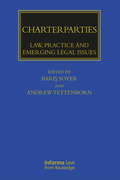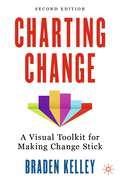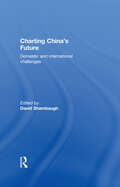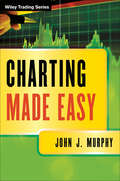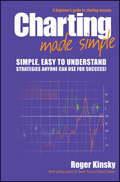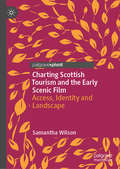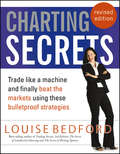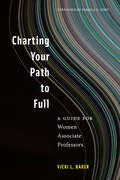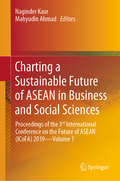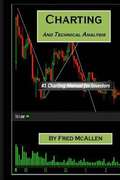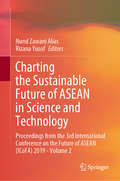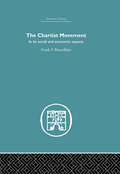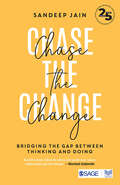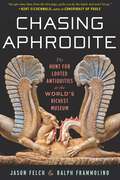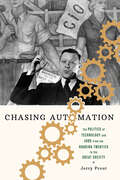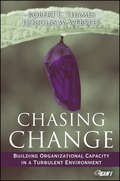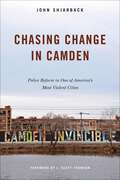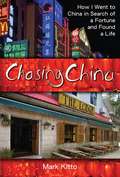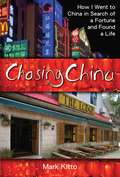- Table View
- List View
Charterparties: Law, Practice and Emerging Legal Issues (Maritime and Transport Law Library)
by Andrew Tettenborn Barış SoyerThis book consists of edited versions of the papers delivered at the Institute of International Shipping and Trade Law’s 12th International Colloquium at Swansea Law School in September 2016. Featuring a team of contributors at the top of their profession, both in practice and academia, these papers have been carefully co-ordinated so as to ensure to give the reader a first class insight into the issues surrounding charterparties. The book is set out in three parts. -Part I offers a detailed and critical analysis of issues of contemporary importance concerning time charters. -Part 2 carries out a similar analysis with regard to voyage charterparties. -Part 3 deliberates issues common to both type of charterparties. Offering critical analysis of contemporary legal issues on charterparty contracts, this book considers recent legal and practical developments and is therefore essential reading for both professional and academic readers with an interest in charterparties.
Charting Change: A Visual Toolkit for Making Change Stick
by Braden KelleyExecutives are under escalating pressure to deliver increasing profits every quarter, while technology advances at an increasing rate. In such a pressure-cooker environment, leaders must hard-wire their organizations to be mindful of costs while simultaneously becoming more flexible and faster at planning and executing the change programs required by innovation and the shifting demands of the customer. The companies that successfully innovate and stay at the top of their industries have one thing in common – they learn fast and manage change well.Charting Change provides a set of visual tools that will help you build a coherent approach to change, identifying both the things that will help make the effort successful, and those people and barriers that will try to block the way. Leaders that read and absorb this book will be able to make productive use of the tools to drive buy-in, alignment, and successful change outcomes across the organization, its systems, and its culture.This second edition features new topics such as architecting for change, overcoming resistance to change, and systems thinking, as well as new visual tools such as the Organizational Agility Framework. This book will help leaders and managers visualize, plan, and execute change and transformation in a more accessible, visual, and collaborative way. Once you are done reading Charting Change you will approach any big change with confidence.
Charting China's Future: Domestic and International Challenges
by David ShambaughEvery day and everywhere, China figures prominently in global attention: companies and banks weigh billions in investments; hedge fund managers assess and speculate on downside risks; commodity traders and natural resource producers salivate over China’s energy appetite; intelligence agencies carefully track China’s growing global footprint; militaries monitor China’s growing military capabilities; diplomats grapple with a new assertiveness in China’s diplomatic posture; scholars try to understand the shifting dynamics and sources of China’s behaviour; while journalists track the latest changes in China’s economy, polity, and society. Charting China’s Future provides informed analysis on the complexities of today’s China, and where these complexities may lead, from some of the world’s leading Asia experts. The contributors have provided clear, intelligible, and forward-looking analyses, free of social science jargon and extensive footnotes. Probing into many of the key domestic and external issues facing China today from political, economic and social perspectives the book proffers a forward-looking analysis that will appeal to anyone with a professional, academic or personal interest in the big issues facing today's China and its interaction with the world. Readers will find much to contemplate about China’s future in this volume, and will gain a clearer sense of the key variables and possible trajectories of one of the most consequential countries on the planet.
Charting Made Easy
by John J. MurphyHere is a treasure trove of easy to use tools for mapping your course through today's market. Whether you're using online charts or a professional charting software program, these techniques from master technician John Murphy can increase your trading success."One of the greatest benefits of technical analysis is its applicability to any and all markets ... charts can be an extremely valuable tool-if you know how to use them. This booklet is a good place to start learning how."--from the foreword by John MurphyRenowned market technician John Murphy presents basic principals of technical analysis in easy-to-understand term.He coversAll types of chart analysis"Need to know" concepts, including trendlines, moving averages, price gaps, reversal patterns, volume & open interest spreads, and more!Price forecasting and market timing applicationsA full resource guide of technical analysis aideHow to use the industry's top tools to obtain a better understanding of what charts can do-and how they can help you grab your portion of today's trading profits.
Charting Made Simple: A Beginner's Guide To Technical Analysis
by KinskyA straightforward guide that answers investors questions and helps them develop their own charting system The fifth book in the Wrightbooks "Made Simple" series, this book gives investors the answers they need to understand and use charting without the expense of a proprietary program. It explains such commonly used charting tools as the moving average indicator and Bollinger brands and shows readers how to combine tools and techniques into a coherent charting system that works for them.
Charting Scottish Tourism and the Early Scenic Film: Access, Identity and Landscape
by Samantha WilsonWhat impact did walking tours and scenic films have on leisure activities? In what ways did working class travel disrupt normative narratives concerning nature and identity? The appreciation of nature and leisure travel have a complex and interrelated history in Scotland. In Charting Scottish Tourism, Wilson looks at how scenic filmmaking altered the construction of the tourist map and spatial identities at the turn of the 20th Century. Scenic film, the author argues, played a key role in the expansion of regional travel and national tourism during the period. In addition, scenic film provides the modern researcher with an unrivalled source of documentary evidence relating to the manner in which Scottish working and middle class communities explored and reclaimed the natural spaces around them. The author examines the central role of the Scottish scenic within leisure performances and the way in which these films promoted and challenged normative spatial narratives. These discursive shifts, she argues, had a wide-reaching impact on popular assumptions concerning space, nature and identity both home and away. Charting Scottish Tourism provides a fascinating case study and numerous methodological insights for students and researchers interested in documentary film as well as the construction of identity and the natural world.
Charting Secrets
by Louise BedfordIt is a common myth that the sharemarket is a fast ticket to the easy life. Buy a few shares and watch them go up. Call your broker for up-to-the-minute price information as you drive the Porsche to the golf club. Yell 'Sell! Sell! Sell' into your mobile as you ski through the Swiss Alps. Nothing could be further from the truth.Louise Bedford believes that the only way to be successful in the market is to spend time studying and putting in the hard work, just like any other job. With this in mind, she has written Charting Secrets. Not just another trading book, Charting Secrets is a workbook that will have you practising what you have read, and really learning the techniques, rather than just reading about them. Louise starts with explanations of charting patterns and methods, and provides charts for you to practise on. She then provides step-by-step solutions so you can compare your results with hers. In this workbook you will learn the secrets of:charting basicslines, volume and moving averagesmacro reversal and continuation patternscandlestick charting and system development going long and short trading psychology -- and much more.In her usual easy-to-read style, Louise will have you recognising v-reversals, shooting stars, share stages, double tops, triangles and tasuki gaps in no time.
Charting Your Path to Full: A Guide for Women Associate Professors
by Vicki L. BakerInstitutions, faculty, and students benefit when women academics advance in their careers, yet research shows that women academics are more likely to stall at the associate professor stage of their careers than men. Charting Your Path to Full is a data- and literature-informed resource aimed at helping women in the professoriate excel in their careers, regardless of discipline and institution type. Vicki L. Baker draws on human resources, organizational studies, and positive organizational psychology to help women first focus on their joy as the primary driver of career and personal pursuits, and provides action steps, “To Do” lists, and additional tools and resources to lay out a clear step-by-step approach to help women academics reach their goals. Baker’s wealth of consulting and research insights provides a compelling and accessible approach to supporting women as they re-envision their careers.
Charting a Sustainable Future of ASEAN in Business and Social Sciences: Proceedings of the 3ʳᵈ International Conference on the Future of ASEAN (ICoFA) 2019—Volume 1
by Naginder Kaur Mahyudin AhmadThis volume showcases selected conference papers addressing the sustainable future of ASEAN from the perspectives of business and social science disciplines. In addressing the 17 Sustainable Developments Goals (SDGs) envisioned by the United Nations in the domains of environment, health and well-being, posing potential means of reducing inequalities globally, the authors target specific issues and challenges confronting the fast-growing region of ASEAN and present suggestions for co-operation and commitment from governments, non-governmental organisations (NGOs) and society at large, in line with the ASEAN Vision 2020. Papers are selected from the 3rd International Conference on the Future of ASEAN (ICoFA) 2019, organised by Universiti Teknologi MARA in Malaysia, whose conference theme “Charting the Sustainable Future of ASEAN” enables intellectual discourse on sustainability issues from business and the social sciences, as well as science and technology. The selection of papers is published in two volumes, comprising scholarly and practical insights into sustainability in ASEAN. This first volume of papers from business and social science scholars will be of interest to researchers and policymakers interested in sustainability developments in the ASEAN region.
Charting and Technical Analysis
by Fred McallenTo invest successfully or trade in Stocks, Options, Forex, or even Mutual Funds, it is imperative to know AND understand price and market movements that can only be learned from Technical Analysis. You should NEVER attempt Trading or Investing without it! My 25 years experience has taught me that 'every book on the market' regarding Charting and Technical Analysis is seemingly worthless. All seem to find yet another creative way to tell you to “Buy Low and Sell High.” And they offer NO in-depth understanding or analysis about WHO is buying and WHO is selling, and when. Point is, anyone, experienced or not, can show you a picture of a Chart and tell you to buy at the bottom and sell at the top. That is simple 'hindsight,' and is always 20/20. This book is different! It is IN-DEPTH – EXPLAINED and you WILL learn price movements and technical analysis from this information! You will understand and recognize tops and bottoms in the market and in particular stocks, AS they are forming. This is highly valuable information, and you should NEVER attempt to trade or invest without this knowledge. Mutual Funds? Most people think they do not need this information because the have a Mutual Fund. That could not be farther from the truth. Investing your hard-earned money should be done with your own knowledge of market direction, when to buy, and when to move your money to safety. Without this knowledge you are at the mercy of a salesperson hungry to earn a commission. Thus, invariably entering the market at the wrong time and in the wrong investment. No one else has your best interest in mind. So learn to protect your money or keep it in the bank. It's that simple. The next move is yours.
Charting the Sustainable Future of ASEAN in Science and Technology: Proceedings from the 3rd International Conference on the Future of ASEAN (ICoFA) 2019 - Volume 2
by Nurul Zawani Alias Rizana YusofThis book showcases selected conference papers addressing the sustainable future of ASEAN from the perspectives of science and technology disciplines. In addressing the 17 Sustainable Developments Goals (SDGs) envisioned by the United Nations in the domains of environment, health and well-being, posing potential means of reducing inequalities globally, the authors target specific issues and challenges confronting the fast-growing region of ASEAN and present suggestions for co-operation and commitment from governments, non-governmental organisations (NGOs) and society at large, in line with the ASEAN Vision 2020. Papers are selected from the 3rd International Conference on the Future of ASEAN (ICoFA) 2019, organised by Universiti Teknologi MARA in Malaysia, whose conference theme “Charting the Sustainable Future of ASEAN” enables intellectual discourse on sustainability issues from science and technology, as well as business and the social sciences. The selection of papers is published in two books, comprised of scholarly and practical insights on sustainability in ASEAN. This book from science and technology scholars is of interest to researchers and policymakers interested in sustainability developments in the ASEAN region.
Chartist Movement: in its Social and Economic Aspects (Routledge Revivals Ser.)
by Frank F. RosenblattProfessor Rosenblatt’s The Chartist Movement was the first serious study of Chartism, using the techniques of modern scholarship, to appear in English. The book comprises a detailed account of the history of the movement, dealing mainly with the period from 1837 until the Chartist riots at Newport, South Wales, in November 1839. As well as describing the political, industrial and social conditions that gave birth to the Chartist movement, this work contains extremely useful statistical tables of the 543 persons who were convicted for offences committed in the furtherance of Chartism between January 1839 and June 1840. "This is a particularly satisfactory piece of work as regards sketches of the leaders of the movement and of the spirit in which they preached the gospel of revolt." - American Historical Review, 1916.
Chase Manhattan Corp.: The Making of America's Largest Bank
by Stuart C. Gilson Cedric X. EscalleChase Bank and Chemical Bank intend to merge, producing the largest commercial bank in the United States, the fourth largest in the world. Projected financial benefits under the merger reflect significant planned reduction in operating costs, including 17,000 employee layoffs. Management also expects the merger to produce significant revenue increases as a result of increased economies of scale and scope, and other benefits of size and market leadership. The task of valuing the merger gains, negotiating an acceptable merger price, and implementing the post-merger restructuring is extremely complex.
Chase Sapphire: Creating a Millennial Cult Brand
by Jill Avery Shelle Santana Christine SnivelyThe launch of the Chase Sapphire Reserve credit card was enthusiastically received by millennial consumers, a cohort that had previously eluded JPMorgan Chase and its competitors. With the one-year anniversary of the launch approaching, managers are focused on retaining customers attracted by a one-time signup bonus of 100,000 reward points and on acquiring new customers now that the bonus had been reduced to 50,000 points. They were also refocusing on the remainder of the Chase Sapphire product portfolio to assess differentiation among the products and to identify white space in the market that could support additional new product launches.
Chase Sapphire: Creating a Millennial Cult Brand
by Jill Avery Shelle Santana Christine SnivelyThe launch of the Chase Sapphire Reserve credit card was enthusiastically received by Millennial consumers, a cohort that had previously eluded JPMorgan Chase and its competitors. With the one year anniversary of the launch approaching, managers are focused on retaining customers attracted by a one-time signup bonus of 100,000 reward points and on acquiring new customers now that the bonus had been reduced to 50,000 points. They were also refocusing on the remainder of the Chase Sapphire product porfolio to assess differentiation among the products and to identify white space in the market that could support additional new product launches.
Chase Sapphire: Creating a Millennial Cult Brand
by Jill Avery Shelle Santana Christine SnivelyThe launch of the Chase Sapphire Reserve credit card was enthusiastically received by Millennial consumers, a cohort that had previously eluded JPMorgan Chase and its competitors. With the one year anniversary of the launch approaching, managers are focused on retaining customers attracted by a one-time signup bonus of 100,000 reward points and on acquiring new customers now that the bonus had been reduced to 50,000 points. They were also refocusing on the remainder of the Chase Sapphire product porfolio to assess differentiation among the products and to identify white space in the market that could support additional new product launches.
Chase the Change: Bridging the Gap between Thinking and Doing
by Sandeep JainThe heaviest burden that anyone can carry is the burden of their unrealized potential, and yet most of us are guilty of carrying this burden. We all know that change does not come easy. It is a process, and we need to make it happen. The book explores what holds us back, the psychology of change, the unconscious biases that interfere with change, and the irrefutable laws of change which we all are aware of but don′t live by. Using his learnings, observations and research, the author has codified the process of personal change in WONDER—an acronym for how to get started with change, build positive habits, motivation and commitment to stay the course, and how to eventually win at change.
Chase's Strategy for Syndicating the Hong Kong Disneyland Loan (A)
by Michael Kane Benjamin C. EstyIn late 1999, the Walt Disney Co. and the Hong Kong government agreed to develop Hong Kong Disneyland, a HK$28 (U.S.$3.6) billion theme park and resort complex planned to open in late 2005. As part of the total financing package, the sponsors decided to raise HK$3.3 billion of non-recourse bank loans for construction and working capital, and selected Chase Manhattan Bank to underwrite and syndicate these facilities. This case concerns the process by which Chase successfully competed to lead this transaction. The key questions facing Chase were whether to bid at all, how to bid, and how to structure the syndication to meet the borrower's needs, its own profit objectives, and the market's expectation for an attractively priced credit. Includes a generic section about the process, participants, and economics of syndicated lending for students who are unfamiliar with syndicated lending. This is part of a module on Financing Projects in the Elective Curriculum (EC) course Large-Scale Investment (LSI). Although written for a course on project finance, it can easily be modified for courses on capital markets or financial institutions.
Chase's Strategy for Syndicating the Hong Kong Disneyland Loan (B)
by Michael Kane Benjamin C. EstySupplements the (A) case.
Chasing Aphrodite: The Hunt for Looted Antiquities at the World's Richest Museum
by Ralph Frammolino Jason FelchIn recent years, several of America’s leading art museums have voluntarily given up their finest pieces of classical art to the governments of Italy and Greece. The monetary value is estimated at over half a billion dollars. Why would they be moved to such unheard-of generosity? The answer lies at the Getty, one of the world’s richest and most troubled museums, and scandalous revelations that it had been buying looted antiquities for decades. Drawing on a trove of confidential museum records and frank interviews, Felch and Frammolino give us a fly-on-the-wall account of the inner workings of a world-class museum and tell the story of the Getty’s dealings in the illegal antiquities trade. The outlandish characters and bad behavior could come straight from the pages of a thriller—the wealthy recluse founder, the cagey Italian art investigator, the playboy curator, the narcissist CEO—but their chilling effects on the rest of the art world have been all too real, as the authors show in novelistic detail. Fast-paced and compelling, Chasing Aphrodite exposes the layer of dirt beneath the polished façade of the museum business.
Chasing Automation: The Politics of Technology and Jobs from the Roaring Twenties to the Great Society
by Jerry ProutChasing Automation tells the story of how a group of reform-minded politicians during the heyday of America's industrial prowess (1921–1966) sought to plan for the technological future. Beginning with Warren G. Harding and the Conference he convened in 1921, Jerry Prout looks at how the US political system confronted the unemployment caused by automation. Both liberals and conservatives spoke to the crucial role of technology in economic growth and the need to find work for the unemployed, and Prout shows how their disputes turned on the means of achieving these shared goals and the barriers that stood in the way. This political history highlights the trajectories of two premier scientists of the period, Norbert Wiener and Vannevar Bush, who walked very different paths. Wiener began quietly developing his language of cybernetics in the 1920s though its effect would not be realized until the late 1940s. The more pragmatic Bush was tapped by FDR to organize the scientific community and his ultimate success—the Manhattan Project—is emblematic of the technological hubris of the era.Chasing Automation shows that as American industrial productivity dramatically increased, the political system was at the mercy of the steady advance of job replacing technology. It was the sheer unpredictability of technological progress that ultimately posed the most formidable challenge. Reformers did not succeed in creating a federal planning agency, but they did create a enduring safety net of laws that workers continue to benefit from today as we face a new wave of automation and artificial intelligence.
Chasing Change
by Bob Thames Douglas W. WebsterRobust organizational capacity is a company s potential to apply its skills and resources to accomplish goals and exceed stakeholders expectations. This book provides readers with the ability to diagnose both the drivers of change in their organization and the type of change response needed. In addition to the traditional tangible dimension of change, it presents a framework to leverage the cultural and personal dimensions of change to sustain successful change initiatives. As well, it presents an organizational capability self-assessment process to derive the maximum return on change efforts and investments. CEOs and executives will benefit from the ability to link demands for change to organizational capabilities in strategic initiatives.
Chasing Change in Camden: Police Reform in One of America's Most Violent Cities
by John ShjarbackIn the 1990s and 2000s, Camden, NJ, across the river from Philadelphia, was perennially designated one of America’s most dangerous cities. The functionally bankrupt city dissolved the Camden Police Department (CPD) and created the Camden County Police Department (CCPD) in 2013, refocusing its priorities and officer performance standards to engage with the community and build trust. The change was significant, with notable drops in violent crime and murder. However, concerns about the use of force and other aggressive practices continued. In Chasing Change in Camden, John Shjarback investigates how Camden’s police department re-formed and questions whether it can serve as a model for other cities. He analyzes successful policies—from innovative police training to advancements in technology—and evidence-based policing strategies. Shjarback explains how the changes were implemented and then adjusted in response to community backlash. Chasing Change in Camden concludes with a discussion of threats to the reform and accountability efforts in both the CCPD and American policing more broadly. Ultimately, Camden’s case study offers valuable lessons for cities seeking effective police reform.
Chasing China: How I Went to China in Search of a Fortune and Found a Life
by Mark KittoAn astonishing, cautionary tale of how Westerner Mark Kitto built a successful media empire in China, creating and running 3 magazines, only to have the state take his business, and his livelihood, away. I had fought off attacks from jealous rivals and been investigated by every bureau with the slightest connection to publishing, and by many who did not: nine in total. I had paid over 1 million Yuan in fines, and who knows how much more in administration fees to government 'agencies. ' I had been accused of being a pimp, a China 'splittist,' a Falun Gong supporter, a pornographer and a spy. My staff had been extradited, my office computers confiscated, and my magazines impounded at the printers. I had got them all back. I had been through eight government publishing partners before China Intercontinental Press, and half a dozen advertising agencies. Mark Kitto on his experience as a business owner in China.
Chasing China: How I Went to China in Search of a Fortune and Found a Life
by Mark KittoAn astonishing, cautionary tale of how Westerner Mark Kitto built a successful media empire in China, creating and running 3 magazines, only to have the state take his business, and his livelihood, away. "I had fought off attacks from jealous rivals and been investigated by every bureau with the slightest connection to publishing, and by many who did not: nine in total. I had paid over 1 million Yuan in fines, and who knows how much more in administration fees to government 'agencies.' I had been accused of being a pimp, a China 'splittist,' a Falun Gong supporter, a pornographer and a spy. My staff had been extradited, my office computers confiscated, and my magazines impounded at the printers. I had got them all back. I had been through eight government publishing partners before China Intercontinental Press, and half a dozen advertising agencies.” -Mark Kitto on his experience as a business owner in China
